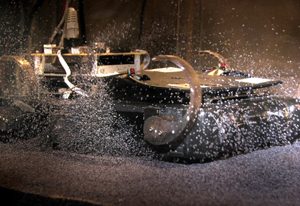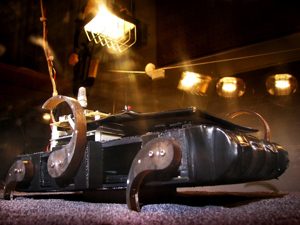Studying Animals to Build a Better Robot
 Land animals use a precise combination of good body design and behavioral smarts to run, hop, climb, adapt quickly to icy conditions, and walk with ease over sand or gravel. Daniel Koditschek, professor in the departments of Electrical and Systems Engineering, Computer and Information Science, and Mechanical Engineering and Applied Mechanics looks to these animals for insight. Chair of Electrical and Systems Engineering, Koditschek has been inspired by animals like the cockroach and gecko to create legged robots capable of climbing or moving over tricky terrain in the same way.
Land animals use a precise combination of good body design and behavioral smarts to run, hop, climb, adapt quickly to icy conditions, and walk with ease over sand or gravel. Daniel Koditschek, professor in the departments of Electrical and Systems Engineering, Computer and Information Science, and Mechanical Engineering and Applied Mechanics looks to these animals for insight. Chair of Electrical and Systems Engineering, Koditschek has been inspired by animals like the cockroach and gecko to create legged robots capable of climbing or moving over tricky terrain in the same way.
In a study published in the Proceedings of the National Academy of Sciences, Koditschek, post-doctoral researcher Haldun Komsuoglu, and colleagues from both Georgia Tech and Northwestern have figured out a way to help legged robots move through granular, sandy terrain.
Sand contains both solid and liquid properties and requires robots to manage subtle changes in stride. With funding from the Burroughs Wellcome Fund, the Army Research Laboratory, and the National Science Foundation (NSF), the researchers found some of the secrets to traversing sandy terrain lie in limb motion. SandBot, a machine based on the body of a cockroach and developed by Koditschek and Komsuoglu, simply thrashed and sank if the legs moved quickly. But by slowing down the limb motion at certain points, the researchers found the robot was able to walk successfully.
 “We’ve been trying to understand what geckos and cockroaches do when they climb very rapidly on vertical or near vertical walls,” explains Koditschek. “There’s a huge importance to getting the mechanical hierarchy right and complementing that design with the appropriate behavior.”
“We’ve been trying to understand what geckos and cockroaches do when they climb very rapidly on vertical or near vertical walls,” explains Koditschek. “There’s a huge importance to getting the mechanical hierarchy right and complementing that design with the appropriate behavior.”
Now, Koditschek and his team from Penn Engineering’s General Robotics, Automation, Sensing, and Perception (GRASP) Lab are exploring if the tables can be turned, and if robots can serve as physical models to help biologists better understand animal locomotion. The work is being completed with funding from the NSF and in collaboration with researchers at the University of California, Berkeley.
It’s possible that legged robots may one day be used in dangerous search-and-rescue operations and extraterrestrial exploration. But Koditschek cautions that there’s a tremendous amount of fundamental work left to do.
“Robots remain amazingly primitive,” he says, “even relative to the so-called simplest animals such as cockroaches or lizards.”
Credits: Research at Penn, “Studying Animals to Build a Better Robot,” Volume 8, page 15. Photography by Lionel London.
